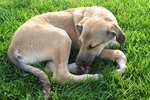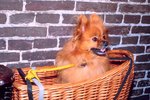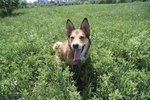
Many of our furry friends groom themselves regularly. Cats, rabbits, guinea pigs and other small mammals generally, if healthy, require only minimal assistance in this department. However, with all that self-bathing, especially in our long-haired, furry friends, ingestion of hair is inevitable. We often associate hairballs with cats, but that's simply because we sometimes see them in the act. Unfortunately, guinea pigs and other rodents don't have the same regurgitation reflex, making hairballs a scarier situation.
A Day in the Life of a Guinea Pig
Guinea pigs are small, domesticated, tailless rodents. Beloved pets to many, there are 13 species varying in appearance and hair length. Crepuscular species, meaning they are most active at dusk and dawn, they spend their time awake feeding, burrowing and enthusiastically grooming themselves. As all guinea pigs are domesticated either as pets or food at this points, their diets consist of what choices we make for them. Fortunately, this can have an enormous impact on their grooming behavior and quality of their coat.
Grooming Behavior
Guinea pigs are social creatures and, in addition to self-grooming, will socially groom their neighbors. By secreting a milky-white lubricant from their eyes and rubbing it into their fur, they are able to keep themselves clean and help protect skin from infection and parasites. Unfortunately, during this process a cavy will use its tongue and mouth to disperse the lubricant and bite away debris. Hair ingestion is an inevitable part of this process
What Happens When Hair is Ingested
Ingesting a small amount of hair is usually not a problem for otherwise healthy guinea pigs. Shedding of a healthy fur coat is minimal, and the digestive tract of an active guinea pig easily passes the hair along. However, over-grooming, especially in long-haired species, lack of a high-fiber diet or other digestive problems can create stasis whereby hair accumulates and cannot pass. What makes this so dangerous is the rodent's unfortunate inability to vomit. This anatomical anomaly is not fully understood, but it's suspected to be a neurological issue universal to rodents.
Remedies
Avoiding possible surgery to remove large quantities of accumulated hair is obviously ideal, so prevention is key. A high-fiber diet of with appropriate pellets, vegetables and hay -- such as the high-fiber timothy hay -- will be most beneficial to maintain a healthy digestive tract. Along with appropriate vitamins, minerals and supplements (as directed by a veterinarian) for a healthy coat and grooming behaviors, dangerous hairballs can be avoided.
References
Photo Credits
-
Michael Blann/Digital Vision/Getty Images
Writer Bio
Working with both small animals and exotics, Pamela Meadors has devoted more than 15 years to the veterinary field. She possesses a bachelor's degree in biological sciences and is the proud mom of a blind hedgehog.




